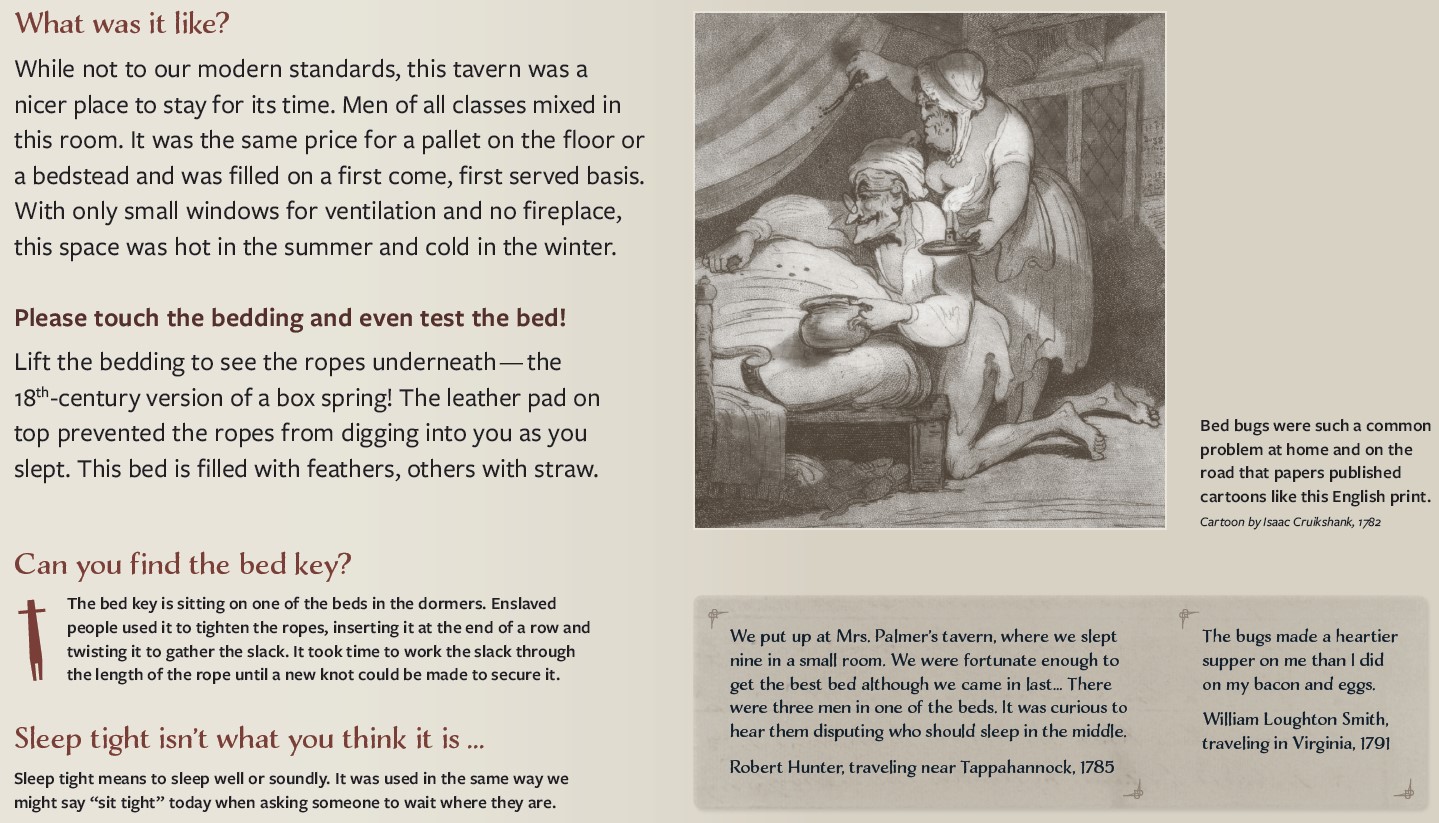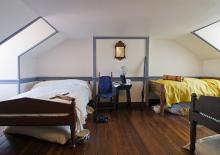
Tour Gadsby's Dormer Sleeping Rooms
Deep Dive Information
On-Site Exhibit

Dormer Sleeping Room
Taverns offered no privacy, simply the promise of a place to lie down.
Tavern keepers were required by law to offer overnight lodging. The price was regulated, set at 20 cents per night. At 50 cents, the main meal was more expensive than the accommodations. While these amounts may not sound like much, the average daily wage was $1 to $1.50, making travel costly. Generally, white men of some means stayed in rooms like this when traveling for business.
Where did enslaved travelers sleep?
Records do not tell us much about the experience of enslaved men when they traveled. Those traveling on their own (with a pass from their “owner”) may have slept in the outbuildings with the enslaved men who worked here. But a white traveler may have wished to keep his enslaved manservant closer, even in the dormer space itself.
Did women sleep in these rooms?
While white upper-class women occasionally traveled, these sleeping arrangements would not have been their first choice. In cities, there were more appropriate alternatives, such as private homes or boarding houses.
Sometimes women traveling outside of cities had to share a tavern room with men. Mrs. Elizabeth House Trist wrote of how she created some privacy during her travels along the Ohio and Mississippi Rivers in 1783: “we had a little partition run along the side of our bed, and we hung our great coats up at the foot, which made our berth very private.”
“They [Americans] do not roam about except on business. To them, just for sleeping, only a bed is necessary; they do not need a room for they run about town all day, furthermore they have very little baggage, elegance in amenities is unknown to them.” –Prussian traveler Johann Schoepf, from Travels in the Confederation, 1783-84

What was it like?
While not to our modern standards, this tavern was a nicer place to stay for its time. Men of all classes mixed in this room. It was the same price for a pallet on the floor or a bedstead and was filled on a first come, first served basis. With only small windows for ventilation and no fireplace, this space was hot in the summer and cold in the winter.
Please touch the bedding and even test the bed!
Lift the bedding to see the ropes underneath—the 18th-century version of a box spring! The leather pad on top prevented the ropes from digging into you as you slept. This bed is filled with feathers, others with straw.
Can you find the bed key?
The bed key is sitting on one of the beds in the dormers. Enslaved people used it to tighten the ropes, inserting it at the end of a row and twisting it to gather the slack. It took time to work the slack through the length of the rope until a new knot could be made to secure it.
Sleep tight isn’t what you think it is…
Sleep tight means to sleep well or soundly. It was used in the same way we might say “sit tight” today when asking someone to wait where they are.
[image] Bed bugs were such a common problem at home and on the road that papers published cartoons like this English print. Cartoon by Isaac Cruikshank, 1782
“We put up at Mrs. Palmer’s tavern, where we slept nine in a small room. We were fortunate enough to get the best bed although we came in last…There were three men in one of the beds. It was curious to hear them disputing who should sleep in the middle.” –Robert Hunter, traveling near Tappahannock, 1785
“The bugs made a heartier supper on me than I did on my bacon and eggs.” –William Loughton Smith, traveling in Virginia, 1791
Additional Signage
Chamber pot: Chamber pots were portable shared bathrooms. Enslaved children emptied them into the outhouse or “necessary” every morning. Imagine the smell in this space!
What is behind this door? (one immediately at top of stairs): This served as a closet, though it now houses our heating and air system. It is difficult to close, so we ask that you do not open this door. Imagine this room without central heating or air. What did they do to help make this room warmer or cooler?
What is behind this door? (at end of bed): This was another dormer room similar to the one you are in. It is now used for storage.
Tour the Tavern
- Private Dining Room
- Assembly Room
- Dormer Sleeping Rooms YOU ARE HERE
- Passage
- East Bedchamber
- Ballroom
